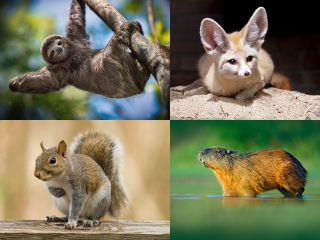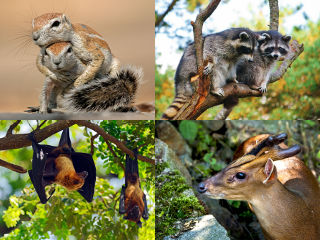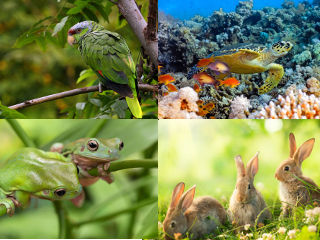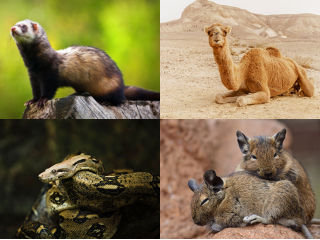California is well known for its beautiful and diverse landscapes, from major cities to national forests to the Pacific Ocean. But what about the animals that call California home? Some of them can be quite dangerous to humans. California is home to various large predatory animals on both land and sea, as well as venomous snakes, spiders, and even killer bees! Today we'll take a deep dive into the top ten most dangerous animals in California and highlight some of their characteristics and behaviors. And, of course, we'll talk about how to appreciate these animals from a distance!
Black Bears
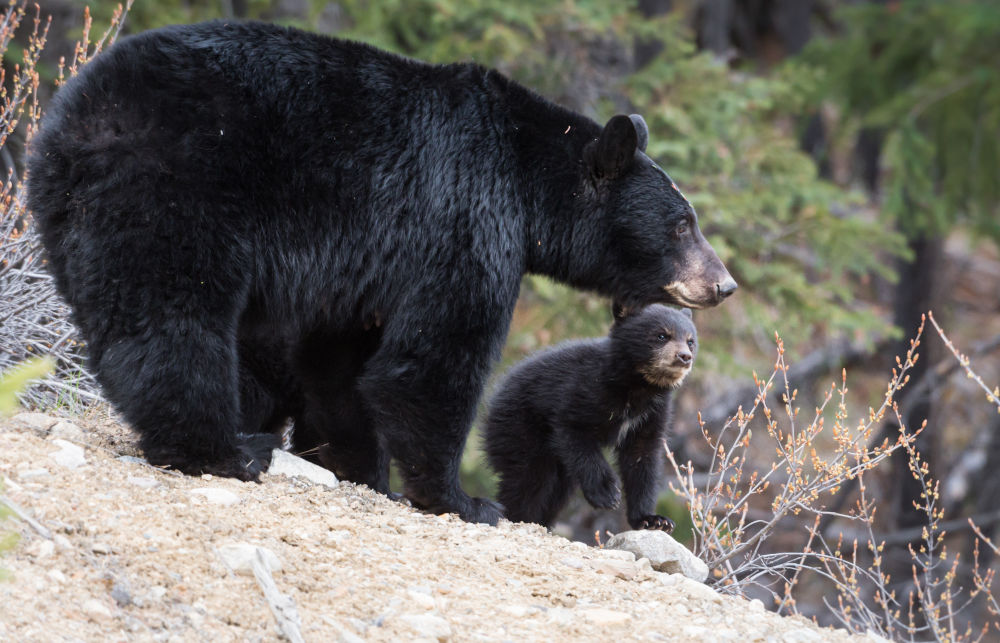
Black bears are large intimidating animals, but with their narrow heads and little ears, they could almost be the inspiration for teddy bears! However, they certainly don't act like teddy bears. Black bears are incredibly powerful animals with strong and sharp claws on the front and hind feet. Females typically weigh between 100 and 200 pounds, while males weigh between 150 and 350. However, there have been males recorded weighing as much as 500 pounds.
Bears are omnivorous animals meaning they eat both plant and animal matter. They are opportunistic regarding food and will eat just about anything in sight. They eat live prey like fawns, birds, and unfortunately sometimes pets, but they will also eat dead animals. They also will eat various plants, berries, acorns, and insects.
Black bears can be found in a wide variety of areas throughout California. They've been known to call grasslands, desert areas, valleys, and the wilderness just outside of urban areas home.
Black bears do not hibernate throughout the entire winter, but they do take a few months during the winter to hibernate. They hunker down into dens and live off of their own body fat while their metabolic rate is cut in half. In just those two months or so, black bears usually lose somewhere between 15 to 30 percent of their body weight and sometimes even as much as 40 percent.
A Black bear will often be quite expressive when they feel threatened. An angry bear will snarl, bare its teeth, and salivate while opening and closing its mouth in rapid succession. While doing this, they often make what can be described as chomping or clacking noises. An aggressive bear will usually walk with its head hunched down below the shoulders. They have been known to charge at threats by running full speed but will sometimes stop just short to give the threat, for example, a coyote, a chance to leave without a fight.
Black bears are not often aggressive towards humans and tend to flee before humans even see them. Most incidents occur when bears are attracted to unsecured food sources at campsites or if humans accidentally get too close to a protective mother.
If you ever find yourself face to face with a black bear, do not run, and do not play dead. You can't outrun or out climb a black bear. When they are displaying threatening behaviors like snarling, swatting at the ground, or blowing or snorting loudly, they are trying to communicate that you need to go. Listen to the bear and back away while still facing the bear. Speak in a calm manner to let the bear know you are not a threat.
Mountain Lions
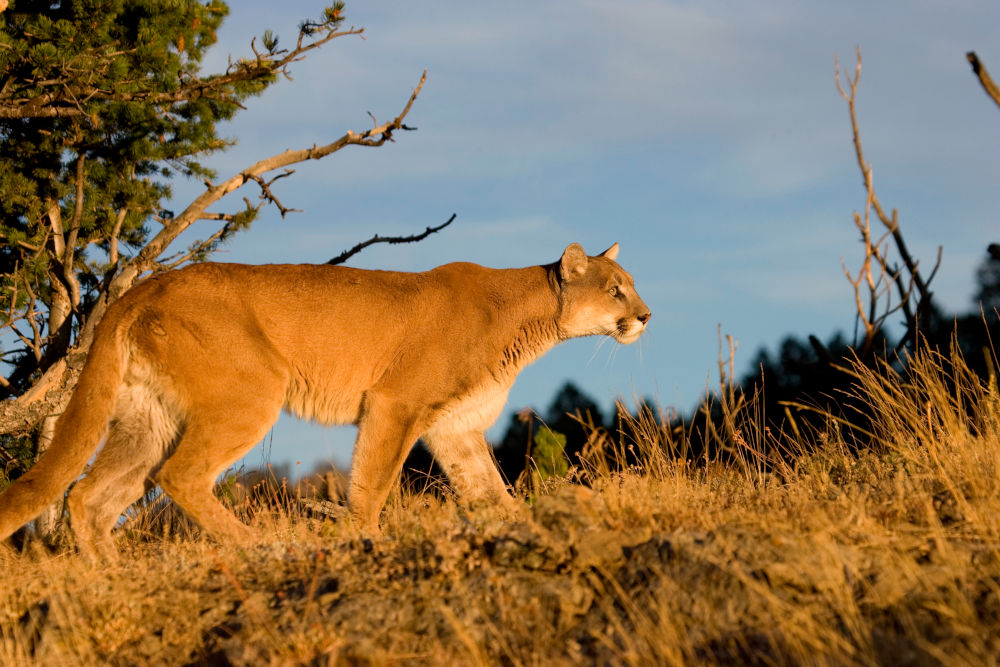
Mountain lions are large, powerful animals that can be found in mountainous areas, open spaces, and just outside urban areas in California. They are quite calm and solitary animals and usually hunt alone. Adult male mountain lions weigh between 130 and 150 pounds and measure about eight feet long. Adult female mountain lions are about 7 feet long and weigh between 65 and 90 pounds.
Mountain lions are carnivorous animals and mostly prey on deer and other wildlife. But if the opportunity presents itself, they have been known to prey on unsupervised pets, as well as livestock.
If ever faced with a mountain lion, do not approach it and give it plenty of space. They tend to want to avoid conflict and will likely flee if they have a clear escape route. You, however, should not run. That will only make you look like prey. Stay calm and stay facing the animal. Raise your arms and try to make yourself look bigger and more intimidating.
Coyotes
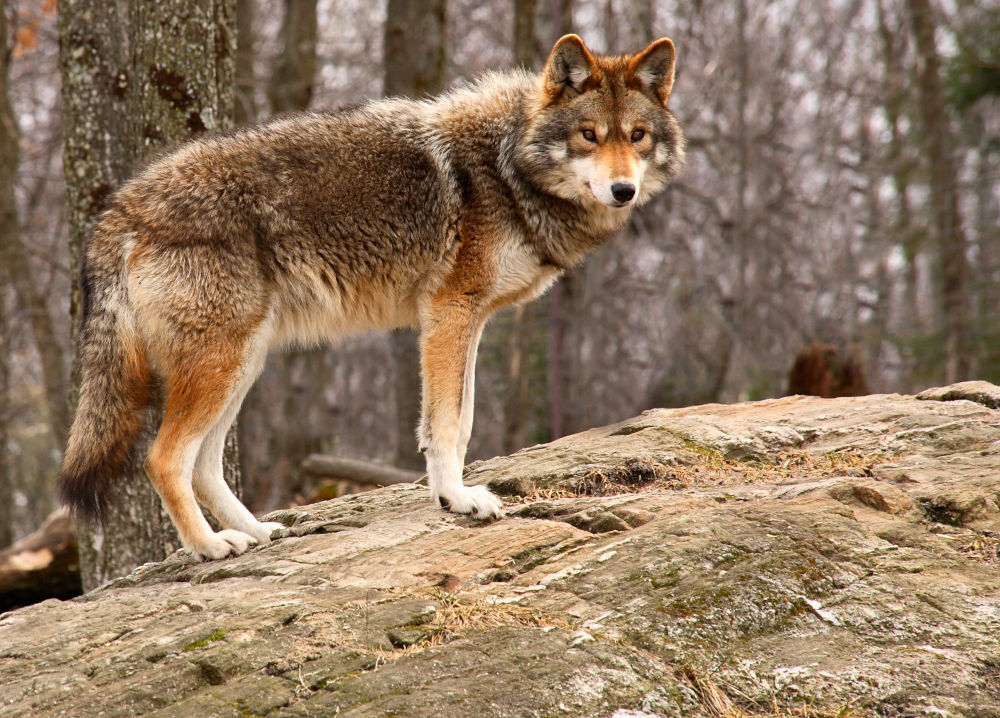
Coyotes are cute, dog-like animals, but they can be vicious predators. They can sometimes be mistaken for wolves but are significantly smaller. The average coyote weighs between 25 and 40 pounds.
Though they are vicious to their prey, thankfully, by nature, they are fearful of humans and often play a key role in semi-urban and residential areas by keeping rodent populations down. They'll eat just about anything, including rabbits, carrion, lizards, snakes, fish, and even fruits, vegetables, and insects.
Though they are usually fearful of humans, there are times when they get too much access to human food and garbage and start coming too close for comfort. In these cases, they start to like the convenience of easy food from garbage and begin to feel more comfortable around humans. They will also harass and kill livestock and pets.
Rattlesnake

The Rattlesnake, though generally not aggressive, is still a dangerously venomous snake that can be found in various parts of California. They are most often found in rocky areas, deserts, and woodlands. There are seven species of rattlesnakes in California. These include Mohave rattlesnakes, Panamint rattlesnakes, Red diamond rattlesnakes, Sidewinders, Speckles rattlesnakes, Western diamond-backed rattlesnakes, and Western rattlesnakes.
Their most famous feature is their rattle located at the end of their tail. They shake their rattle when threatened and warn potential predators.
The rattle at the end of their tails is actually made of keratin, the same substance that fingernails are made of! Every time a snake sheds its skin, a new segment of keratin is added to the rattle. Each segment is hollow, and when the snake shakes its tail, these hollow segments clack up against each other, making that famous rattling sound.
Snakes are not known for having great eyesight, but they have other ingenious ways of detecting their prey. For example, they have a forked tongue that can help them to smell better and can even detect their prey that way. Moreover, they also have specialized pits on the side of their heads, in between their eyes and nostrils. These pits are temperature sensitive which can help the snake find warm-blooded prey.
In order to attack their prey and to defend themselves if need be, they produce venom in glands located behind their eyes, which then can flow into their fans, which are hollow to allow room for the venom. Interestingly, their fangs actually fold back against the roof of their mouth when not in use and only pivot forward when the snake is ready to strike and inject its venom.
Thankfully, rattlesnakes will usually avoid people and larger animals like cats and dogs. They usually prefer to eat lizards, mice, rats, and maybe an occasional squirrel. Never touch or provoke a rattlesnake and do your best to give it room to escape if you ever encounter one. They usually will only attack if they feel threatened with no room to escape.
Sometimes they may do what's called a "dry bite," which is a bite when no venom is produced. Producing venom and biting expends a lot of energy for them, which causes them to be depleted. Nevertheless, all bites should be assumed to be venomous and should receive immediate medical attention.
Great White Shark

There are many different types of sharks in the ocean. However, Great White Sharks are undoubtedly the most well-known and commonly seen sharks in the Pacific Ocean. They are by no means the biggest, but they do make up the largest number of shark-related incidents in the Pacific Ocean.
As of November 2022, since 1950, there have been 209 shark incidents in California. In this context, an incident refers to an occurrence of a shark touching a human or paddleboard, surfboard, kayak, etc. Of the 209 incidents, 185 were related to a Great White Shark. In this timeframe, all 15 human fatalities relating to sharks involved a Great White Shark. This doesn't necessarily mean that these sharks are hunting humans, however. It's most commonly believed that they simply may not be able to differentiate a swimmer or surfer from their favorite meals, which are seals. Great whites also eat dolphins, sea turtles, sea lions, and porpoises. Juvenile great whites usually eat ocean life that is a bit smaller like stingrays and smaller fish.
Great White Sharks usually grow to be somewhere around 15 feet long, but many have been reported to be as long as 20 feet. Typically, they weigh between 1,000 pounds and 2,500 pounds, but some have been reported to weigh as much as 5,000 pounds.
Great White Sharks have long lifespans and are believed to live for somewhere between 40 and 70 years. In fact, males don't reach maturity until they are 9 to 10 years old. Females don't reach maturity until they are 14 to 16 years old. It is believed that a female shark's gestation period is 12 months long, but neither mating nor a birth has ever been documented.
It is believed that females can have between two and fourteen sharks per litter. They can be up to five feet long when they are born and have a full set of teeth. Once they are born, great white sharks are mostly on their own, and many do not survive their first year. They are at risk of being food for adult great white sharks.
Black Scorpion
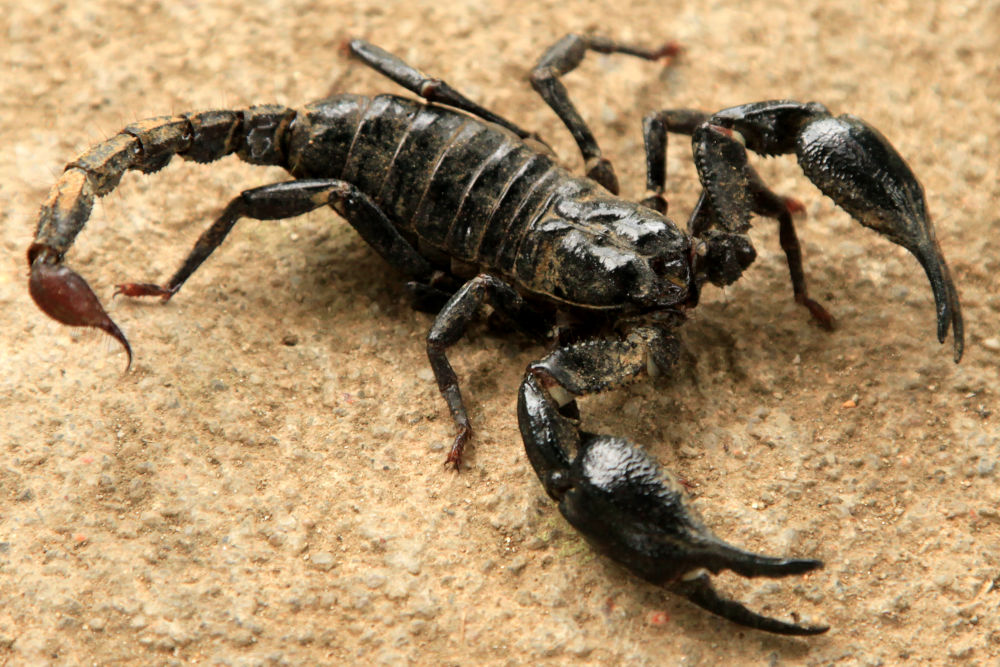
The black scorpion is known for having one of the most dangerous bites of any species of scorpion in the US. They can primarily be found in Arizona, but a significant population is known to reside in southeastern California. They are most commonly found in desert regions but have been known to frequent various grasslands, savannas, and forests.
Thankfully, a sting from a black scorpion is not often fatal. However, a bite is incredibly painful and results in severe symptoms requiring medical attention. Some common symptoms include discomfort, sweating, high blood pressure, diarrhea, vomiting, salivation, allergic reaction, nausea, and convulsions.
In the event of a sting, do your best to remain calm and try not to get too worked up or move too much. Try to wipe away and remove any blood or venom seeping from the wound and bandage the area. Ice cubes can help with the pain.
Scorpions are nocturnal, meaning they only go out at night. They love dark places and like to hide during the day. They eat various kinds of insects, spiders, centipedes, and sometimes other scorpions, small lizards, snakes, or mice.
If you live in an area where scorpions are prevalent, there are a few things you can do to decrease the chances of getting stung. Outside your home, keep trash covered, remove unnecessary rock piles and avoid having any rock piles or wood piles near the house, screen all your doors, windows, and vents, and seal any cracks in the house with mortar or caulk.
Additionally, it's best to always walk around with shoes on, both inside and outside. However, be sure to shake out boots, shoes, and clothes before putting them on, as they tend to be in places where scorpions commonly hide once they've gotten indoors. Also, check closets, beds, and cupboards frequently.
Western Black Widow
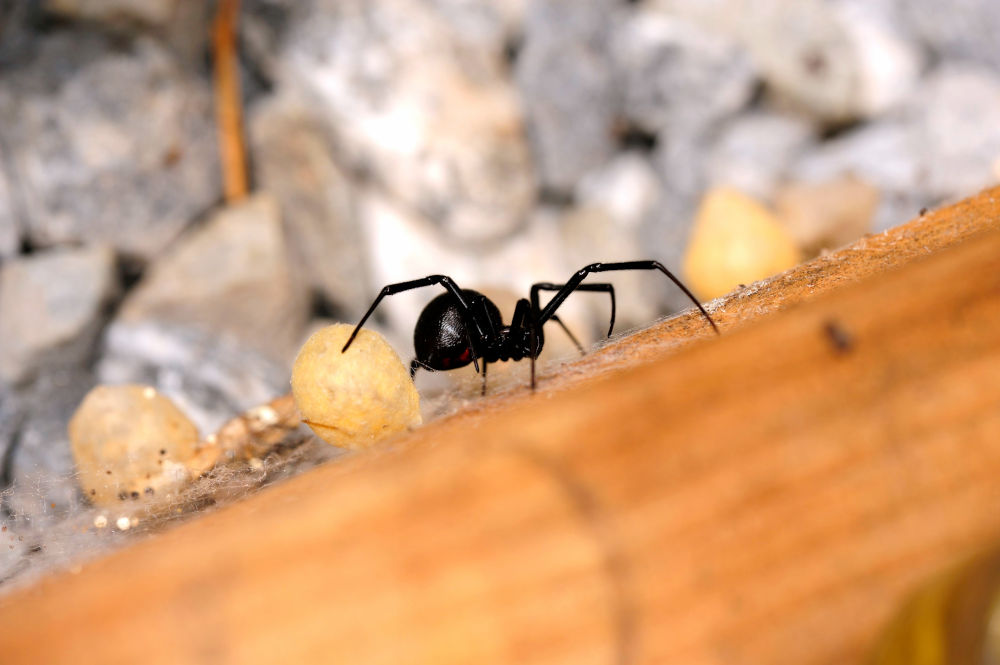
The Western black widow spider is commonly considered to be one of the most dangerous spiders in California. In fact, its venom is said to be fifteen times more powerful than a rattlesnake's venom! Thankfully, an anti-venom has been developed, so fatalities are extremely rare so long as the person gets treatment. Their bites aren't usually more painful than a pin prick, but the venom causes swelling and intense pain and can lead to uncomfortable symptoms. It can cause nausea, muscle cramps, aches, and spasms. Symptoms can increase and last for about 12 hours but then usually start to dissipate. Young children, the elderly, and immune-compromised people are more susceptible to these bites.
These spiders are shy and elusive creatures and typically aren't found in the home except for areas where people don't frequent, like basements and attics. The female black widow's body is about ½ an inch and round in shape. Males are typically about half the size of a female. The females have the infamous red hourglass shape on their abdomens, but the males are typically all black. They usually feed on small insects that get caught up in their web by injecting their venom into the insect, thereby paralyzing them.
Gray Wolves
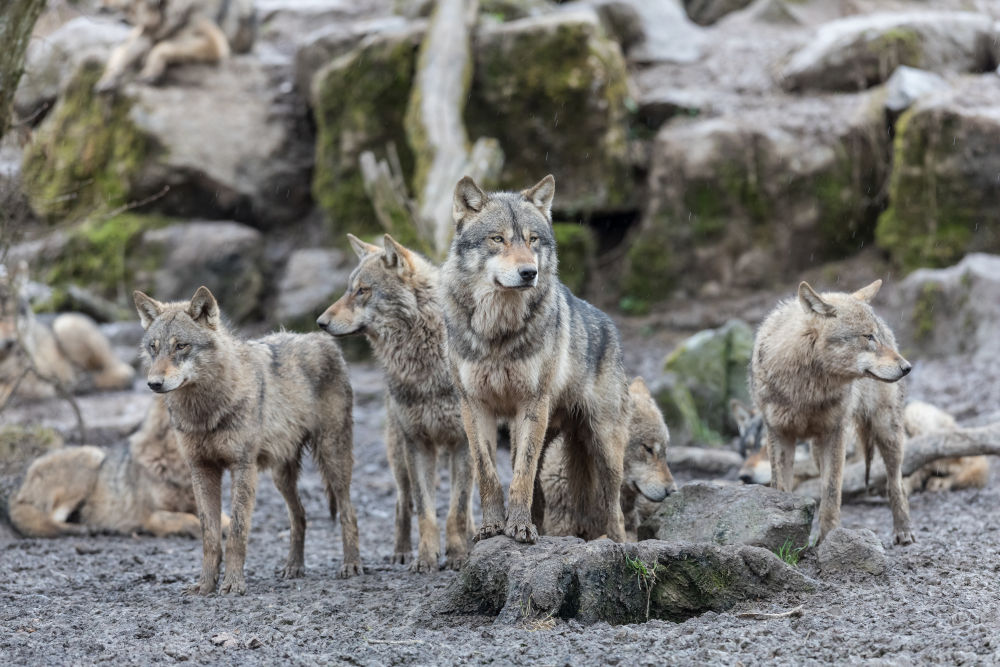
Gray wolves are considered an endangered species in California and are still in the process of recovering. It is prohibited to capture, hunt, or kill these animals. Wolves live in packs, typically of about four to nine members but occasionally more. There is an important social hierarchy in a wolf pack, with an alpha male and female being at the head of the pack.
They use body language and vocalizations like howls, barks, whines, and growls to communicate with one another. In a pack, it is typically only the alpha male and female that reproduce. Pregnancy lasts for about 63 days, and between four and six pups are usually in a litter.
Wolves in California tend to stick to the northern portion of the state, where there are plenty of forests, agricultural land, and rangeland. Wolves are carnivorous animals and primarily hunt deer and elk but have been known to hunt other mammals, reptiles, and birds. They can occasionally be a threat to livestock in circumstances where food sources are scarce, or the opportunity presents itself.
Wolves are large animals and can weigh up to 120 pounds and stand between 26 and 34 inches at the shoulder. Their paw prints can be as big as four inches wide and five inches long. Thankfully, wolves are typically fearful of humans and tend to avoid people. If you happen to have an encounter with a wolf, do not run. Always maintain eye contact and act aggressively, make loud noises, and throw objects while backing up slowly.
Killer Bees
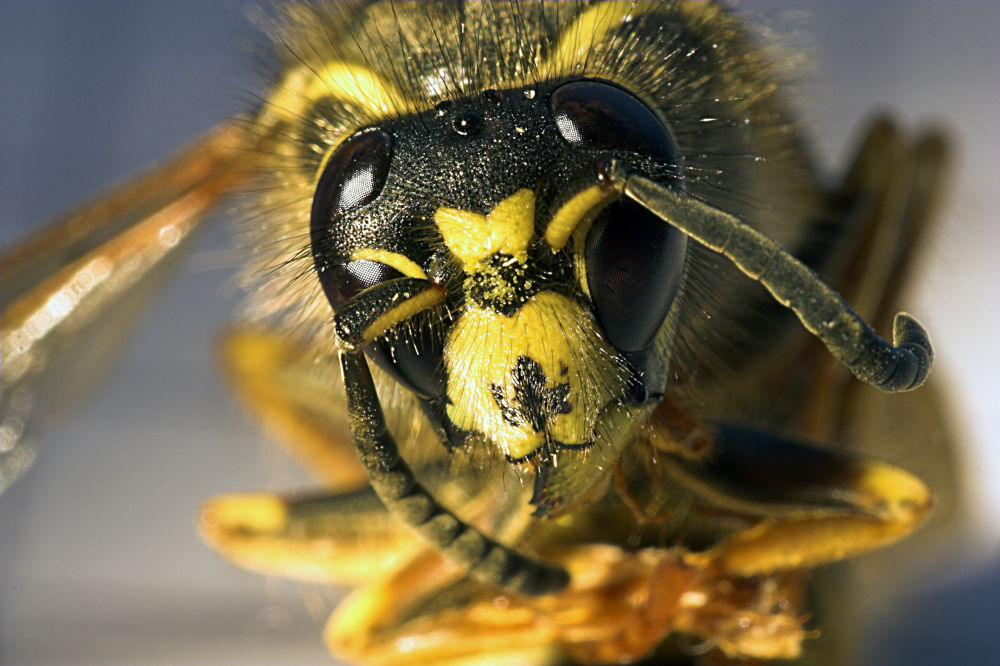
The term killer bees is a common term used to refer to what is more accurately named Africanized honey bees. In the 1950s in Brazil, scientists tried to breed a more efficient honey bee by breeding European honey bees and African honey bees together. The hope was that by combining European honey bees' propensity for greater outputs of honey with African honey bees' tolerance for warmer weather, they could create a species that would thrive in Brazil.
Eventually, some of these colonies escaped and started making their way throughout north and south America. These Africanized honey bees are no more dangerous alone than any other honey bee. However, their strength lies in their numbers, and they know it. They are incredibly defensive and aggressive and will attack in large numbers, earning them the name "killer bees."
European honey bees, in order to defend their colony, will send out about 10 % of their bees to attack. Africanized honey bees, however, will leave the nest almost entirely empty to attack a threat. They have been known to chase people for more than half a mile. Some people have tried to escape the bees by jumping into a body of water, but the bees are determined and will simply wait for people to resurface and will continue their attack.
The best thing you can do if faced with killer bees is to run. Once they give up the chase, you'll likely need to seek medical attention. While the stingers are still in the skin, they are continuously pumping venom. It will be important to scrape out the stinger, if you can, with a fingernail or knife. Healthy adults are usually able to withstand such an onslaught of stings, but for people with venom allergies, even just one bee sting can be extremely dangerous.
Bobcats
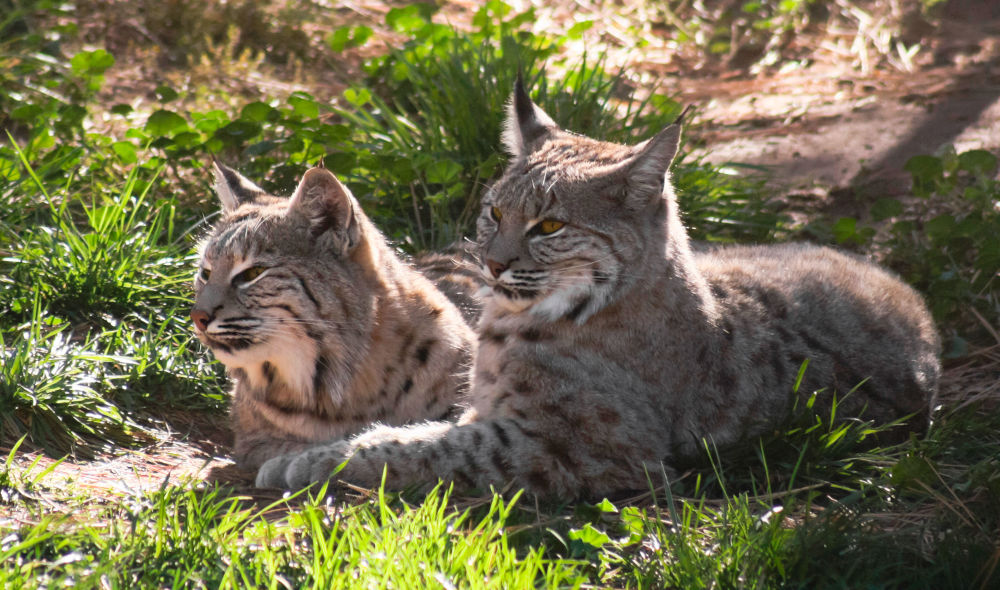
Though much smaller than a mountain lion, Bobcats are another feline that is quite dangerous. Adult Bobcats usually weigh somewhere around 12 to 25 pounds. Their tails are "bobbed," so to speak, and are much shorter than any other cat. They inhabit areas with lots of coverage, like forests, woodlands, and places with lots of vegetation and brush.
Bobcats are carnivorous animals and eat various kinds of wildlife like small fawns, rabbits, porcupines, raccoons, amphibians, reptiles, and some insects. They are opportunistic and will stalk and attack pets and livestock if not in a secured enclosure or supervised. They are mostly solo animals and only associate to mate briefly. Litters usually consist of about three kittens who stay with the mother until about eight months of age, and then they all go their own ways.
As mentioned, Bobcats are shy, solitary animals and typically avoid humans at all costs. If you encounter one in the wild, give it space to escape. If it doesn't leave and you don't feel, you can retreat, yell, stomp your feet, and clap loudly. Again, they typically do not attack humans but will go after unaccompanied pets, so keep your animals supervised and leashed or safely inside, especially at twilight and after dark.
Final Takeaways
California has a great deal of wildlife that call its borders home. Many of these animals can be incredibly dangerous when confronted with humans. For the most part, many of them are more likely scared of us than we are of them and will do their best to stay away from humans. But it is still important to be aware that these animals are out there and to know what to do if ever confronted with one. But overall, the best way to avoid danger is to know the behaviors of these animals and where they are most commonly found. We can still admire these powerful animals, so long as it's done respectfully and safely.
FAQ
What dangerous animals live in california?
There are several dangerous animals that live in California, including: Mountain Lions: These large carnivores can be found in many areas of California, and although they generally avoid humans, they can attack if they feel threatened or if they are starving. Black Bears: California is home to both black bears and brown bears, which can be dangerous if they feel threatened or if they are searching for food. Rattlesnakes: Several species of rattlesnakes live in California, and their venomous bites can be dangerous or even deadly. Great White Sharks: These sharks can be found off the coast of California and can be dangerous to swimmers and surfers. Coyotes: These animals can be found in both rural and urban areas of California and can be dangerous if they feel threatened or if they become habituated to humans. Scorpions: Several species of scorpions are found in California, and their stings can be painful or even dangerous. Western Diamondback Rattlesnake: Found throughout the state, these snakes have a potentially deadly venom.
Why is california's state animal a grizzly bear?
California's state animal is the grizzly bear because it was once a common sight throughout the state. The grizzly bear was a symbol of strength and independence, and it played an important role in the state's history. In fact, the grizzly bear was so important to California's early settlers that it was featured on the state's flag, which was adopted in 1911. The flag shows a grizzly bear walking across a field of green grass with the words "California Republic" written in bold letters above it.
What animals in california are endangered?
California is home to a variety of endangered species, including: California Condor: The California condor is a critically endangered species of bird that is found only in the western United States, including California. The population of California condors declined dramatically due to habitat loss and hunting, and today, there are fewer than 500 individuals left in the world. San Joaquin Kit Fox: The San Joaquin kit fox is an endangered species of fox that is found only in the San Joaquin Valley in California. The population of San Joaquin kit foxes has declined dramatically due to habitat loss and other factors. Mountain Yellow-Legged Frog: The mountain yellow-legged frog is an endangered species of frog that is found only in the mountains of Southern California. The population of mountain yellow-legged frogs has declined dramatically due to habitat loss, disease, and predation. Southern Sea Otter: The southern sea otter is an endangered species of otter that is found along the coast of California. The population of southern sea otters has declined dramatically due to hunting, pollution, and other factors. Desert Tortoise: The desert tortoise is an endangered species of tortoise that is found in the Mojave and Sonoran Deserts in California. The population of desert tortoises has declined due to habitat loss, predation, and disease. Pacific Leatherback Sea Turtle: The Pacific leatherback sea turtle is an endangered species of sea turtle that is found along the coast of California. The population of Pacific leatherback sea turtles has declined due to habitat loss, pollution, and other factors. Delta Smelt: The delta smelt is an endangered species of fish that is found in the Sacramento-San Joaquin Delta in California. The population of delta smelt has declined due to habitat loss, water diversion, and other factors.
What zoo has pandas?
Several zoos around the world have pandas, but the most famous pandas are arguably those at the Chengdu Research Base of Giant Panda Breeding in China. This research center is dedicated to the conservation of pandas and other endangered species, and it is home to a large population of pandas. However, there are also several other zoos and wildlife parks around the world that have pandas, including: San Diego Zoo in California, USA Toronto Zoo in Ontario, Canada Zoo Atlanta in Georgia, USA Smithsonian National Zoo in Washington D.C., USA Adelaide Zoo in South Australia, Australia Zoo Berlin in Berlin, Germany



